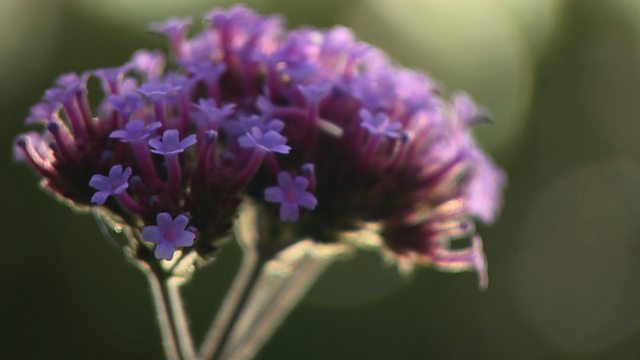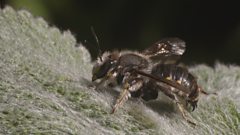
Episode 23
Gardening magazine. Monty Don embraces the new season as he harvests an abundance of produce, and Carol Klein explores the wonders of the fauna visiting gardens.
For many gardeners, the beginning of September is the start of a new season. Monty Don embraces this shift as he harvests an abundance of delicious produce at the same time as looking ahead to the spring.
Carol Klein continues to explore the wonders of the fauna visiting our gardens and travels to Shaftesbury to meet wildlife enthusiast Brigit Strawbridge. Together, they explore the nooks and crannies in her tiny garden to find out what wonderful creatures dwell in these hidden places.
And we visit a hospital in Salisbury where a very special garden, designed by Cleve West, is helping spinal-injury patients on their difficult road to recovery.
Last on
Clips
-
![]()
Horatio’s Garden
Duration: 05:57
-
![]()
Gardening for bees and other insects
Duration: 05:36
Summer and autumn raspberries

Summer raspberries flower and fruit on last year’s growth. Right now the plants should look like a mix of dead canes (with old fruit on) and brand new shoots which are green and full of vigour. Cut back your old dead canes completely leaving no stub and then deal with remaining green canes.
Reduce the number of green canes from each plant so four to eight vigorous shoots remain with space between. Secure the remaining canes onto a strong support (posts, wires or other structures) by tying them in individually, or as Monty does, by weaving one long piece of string around each cane on a wire. The tied-in canes of summer fruiting raspberries will produce fruit next year.Ìý
If your raspberry canes are still green and producing fruit it’s more likely you have autumn fruiting plants. Keep harvesting until the fruit stops and in the winter when the plant is dormant, cut to ground level, these will then shoot from the base next year and fruit on the top of this growth.
Ìý(·É·É·É.°ù³ó²õ.´Ç°ù²µ.³Ü°ì)
Garden featured
Horatio's Garden
The Duke of Cornwall Spinal Treatment Centre
Salisbury District Hospital
Horatio’s Garden has become an essential part of life in the hospital’s spinal treatment centre. It is designed by Cleve West complete with smooth running paths wide enough to take a hospital bed and clever perennial planting. The result isÌýa garden which can be enjoyed by all throughout the year.Ìý
Horatio’s Garden will be open for the National Garden Scheme in July 2015; please see the link to the right for more information. For information on the garden, and the charity which supports it and other spinal unit gardens, see the link below.
(www.horatiosgarden.org.uk)
Planting bluebells

British bluebells, (Hyacinthoides non-scripta) developed in isolation for around 8,000 years on the British Isles, becoming graceful pendulous spring plants of an intense blue hue. In 1683 the Spanish bluebell (Hyacinthoides hispanica) was introduced and started to undo the isolation, hybridising with it and making it more erect, lighter and more vigorous than our native wildflower.Ìý
To ensure the remaining populations of the UK native bluebell are conserved there are now laws protecting the native plants and their sale. The main threats however come from habitat loss and hybridisation. To help prevent hybridisation and therefore the loss of the English Bluebell, try not to plant Spanish bluebells or hybrids anywhere near native populations.Ìý
, Hyacinthoides non-scripta ()
Jobs for the weekend: Yew Cuttings
Choose strong straight shoots of semi-ripe material (growth from this year which is going woody at the base but still soft at the top) and cut to around 10-15cm (Ìý4-6 inches). Prepare the cuttings by removing the lower leaves by a third, plunge the cuttings around the edge of a container filled with free-draining compost. Place outside (or on a warm bench to encourage quicker rooting) andÌýwater. In spring check for roots emerging from the base of pots before potting on.
(www.rhs.org.uk)
Ìý
Jobs for the weekend: Ripen Tomatoes
Whilst it’s still warm, you can ripen tomatoes in the greenhouse on the plant. Remove leaves so the sun can warm fruits. If temperatures inside or out drop below 17-21oC it’s unlikely the tomatoes will ripen. In this case remove the whole plant (remove soil from roots), trusses or individual fruits and ripen indoors in the warm away from direct sunlight. If they still aren’t turning then try placing a ripe banana on or near the fruits, this will introduce more ethylene (the natural gas which is associated with fruit ripening). Finally, if the fruits haven’t fully developed and are quite hard and green they may never ripen but don’t worry, they make great ketchups, chutneys and sauces!
Ìý (www.rhs.org.uk)
Jobs for the weekend: Continue deadheading flowers
Even though there’s a change in season there are still new buds developing on flowering plants. Remove the heads down to a side shoot or new bud to encourage the new bud to burst. Don’t forget however, this will prevent the plant seeding, so remember to keep some heads of plants you wish to collect next year’s seed from.
(ww.rhs.org.uk)
Ìý
Credits
| Role | Contributor |
|---|---|
| Presenter | Monty Don |
| Presenter | Carol Klein |
| Series Producer | Christina Nutter |
| Series Editor | Liz Rumbold |
Broadcasts
- Fri 5 Sep 2014 21:30±«Óãtv Two except Wales
- Sat 6 Sep 2014 20:15±«Óãtv Two Wales
- Sun 7 Sep 2014 09:00
- Thu 18 Sep 2014 10:05


